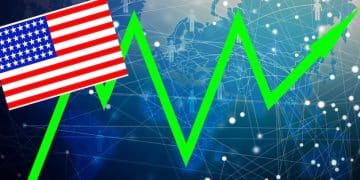How 2.3% GDP Growth in 2025 Will Reshape Your Business Strategy

The projected 2.3% GDP growth in 2025 in the US is expected to create both opportunities and challenges, requiring businesses to adapt their strategies in areas like investment, hiring, and market positioning to capitalize on potential economic expansion and mitigate risks.
Understanding how a projected 2.3% GDP growth in 2025 will impact your business strategy is crucial for staying competitive and making informed decisions.
Understanding the Projected 2.3% GDP Growth
The projected 2.3% GDP growth for 2025 is a significant economic indicator that can have far-reaching effects on businesses. Understanding the nuances of this projection requires delving into what GDP represents and how it is calculated.
GDP, or Gross Domestic Product, is the total monetary or market value of all the finished goods and services produced within a country’s borders in a specific time period. It serves as a broad measure of a nation’s economic activity.
Key Factors Contributing to the Growth
Several factors could contribute to this projected growth. These often include increased consumer spending, business investment, government spending, and net exports. Each of these components plays a vital role in driving economic activity.
- Consumer Spending: Higher consumer confidence and spending power can significantly boost GDP.
- Business Investment: Investments in new technologies, equipment, and facilities can increase productivity.
- Government Spending: Infrastructure projects and other government initiatives can stimulate economic activity.
- Net Exports: A favorable trade balance, with exports exceeding imports, can positively impact GDP.
Understanding these factors enables businesses to anticipate changes and adjust their strategies accordingly. Increased consumer spending might signal a need to increase production, while a rise in business investment could indicate opportunities for collaboration.
In summary, a projected 2.3% GDP growth is more than just a number; it’s a reflection of various economic forces at play. Businesses that understand these forces are better positioned to navigate the future.

Impact on Investment Strategies
A projected GDP growth of 2.3% in 2025 can significantly influence investment strategies for businesses. When the economy is expected to grow, it creates both opportunities and challenges for how companies allocate their capital.
One of the primary impacts is on capital expenditure (CAPEX). Businesses are more likely to invest in expansion, new equipment, and technologies when they anticipate increased demand and higher profits.
Areas for Potential Investment
With a positive economic outlook, businesses might consider expanding into new markets or increasing their presence in existing ones. This expansion could involve opening new locations, launching new products, or increasing marketing efforts.
- Technology Adoption: Investing in new technologies can improve efficiency and productivity, leading to higher profits.
- Research and Development: Allocating funds to R&D can foster innovation and create competitive advantages.
- Infrastructure Upgrades: Improving infrastructure, such as upgrading facilities or transportation networks, can enhance operational capabilities.
- Employee Training: Investing in employee training and development can improve workforce skills and productivity.
However, it’s crucial to balance optimism with caution. Overinvesting can lead to excess capacity and financial strain if the actual growth doesn’t meet expectations. Therefore, a data-driven approach is essential.
In conclusion, a projected 2.3% GDP growth can open up various investment opportunities, but it’s important for businesses to carefully assess their risk tolerance and conduct thorough due diligence before making any major investment decisions.
Workforce Planning and Hiring
The anticipated 2.3% GDP growth in 2025 has significant implications for workforce planning and hiring strategies. As the economy expands, businesses often need to adjust their staffing levels and skill sets to meet increasing demand.
A growing GDP typically leads to increased job creation. Businesses need to hire more employees to support higher production levels, expanded operations, and new projects.
Strategies for Effective Workforce Planning
To effectively manage workforce needs, businesses should adopt a proactive approach to hiring and training. This involves anticipating future skill requirements and ensuring that the workforce is adequately prepared.
- Skills Gap Analysis: Identify any gaps in the existing workforce’s skills and develop training programs to address them.
- Recruitment Strategies: Implement targeted recruitment strategies to attract qualified candidates.
- Retention Programs: Develop programs to retain valuable employees, such as offering competitive salaries, benefits, and career development opportunities.
- Flexible Staffing Solutions: Consider using temporary or contract workers to handle short-term increases in demand.
However, businesses also need to be mindful of potential challenges, such as increased competition for talent and rising labor costs. Strategies for managing these challenges include offering competitive compensation packages, providing opportunities for career advancement, and fostering a positive work environment.
In summary, the projected 2.3% GDP growth in 2025 necessitates careful workforce planning and hiring strategies. By anticipating future needs and addressing potential challenges, businesses can ensure they have the right talent to capitalize on economic opportunities.

Marketing and Sales Adjustments
A projected 2.3% GDP growth in 2025 will likely necessitate adjustments to marketing and sales strategies. As the economy grows, consumer behavior and market dynamics can change, requiring businesses to adapt their approaches.
One primary impact is an increase in consumer spending. With greater economic confidence, consumers are generally more willing to make discretionary purchases, creating opportunities for businesses to boost sales.
Effective Marketing Strategies
To capitalize on this increased spending, businesses should consider adjusting their marketing strategies to target specific consumer segments and highlight the value of their products or services.
- Digital Marketing: Invest in digital marketing channels, such as social media, email marketing, and search engine optimization (SEO), to reach a wider audience.
- Personalized Marketing: Use data analytics to personalize marketing messages and offers, increasing engagement and conversion rates.
- Content Marketing: Create valuable and engaging content that educates and informs consumers, building trust and credibility.
- Promotional Offers: Offer discounts, promotions, and incentives to attract new customers and retain existing ones.
However, it’s also crucial to monitor market trends and consumer preferences closely. Economic growth can lead to increased competition, requiring businesses to differentiate themselves and offer unique value propositions.
In conclusion, the projected 2.3% GDP growth in 2025 necessitates adjustments to marketing and sales strategies. By understanding changing consumer behavior and market dynamics, businesses can effectively target their efforts and drive sales growth.
Supply Chain Considerations
The anticipated 2.3% GDP growth in 2025 will have notable implications for supply chain management. As economic activity increases, businesses need to ensure their supply chains are robust and resilient enough to meet rising demand.
One of the primary considerations is the potential for increased demand on suppliers. With more businesses ramping up production, suppliers may face challenges in meeting their obligations, potentially leading to shortages and delays.
Strategies for Supply Chain Optimization
To mitigate these risks, businesses should adopt proactive strategies to optimize their supply chains. This involves diversifying suppliers, improving inventory management, and investing in technology to enhance visibility and coordination.
- Supplier Diversification: Reduce reliance on single suppliers by developing relationships with multiple vendors.
- Inventory Management: Optimize inventory levels to balance supply and demand, minimizing the risk of stockouts or excess inventory.
- Technology Adoption: Invest in supply chain management software to improve visibility, coordination, and decision-making.
- Contingency Planning: Develop contingency plans to address potential disruptions, such as natural disasters or geopolitical events.
However, it’s also important to consider the potential for increased transportation costs and logistical challenges. Higher demand for shipping and transportation services can drive up prices and lead to delays.
In summary, the projected 2.3% GDP growth in 2025 necessitates careful attention to supply chain management. By optimizing their supply chains and mitigating potential risks, businesses can ensure they can meet rising demand and maintain operational efficiency.
Financial Planning and Risk Management
A projected 2.3% GDP growth in 2025 requires careful financial planning and risk management. While economic growth generally presents opportunities, it also brings potential risks that businesses must manage to maintain stability and sustainability.
One key consideration is managing cash flow. As businesses expand and invest, they need to ensure they have sufficient cash on hand to cover expenses and meet financial obligations.
Strategies for Effective Financial Planning
To manage cash flow effectively, businesses should develop detailed financial plans and budgets, monitor their financial performance closely, and consider strategies for managing debt and equity.
- Budgeting and Forecasting: Develop detailed budgets and financial forecasts to anticipate future revenue and expenses.
- Financial Monitoring: Monitor financial performance regularly to identify potential issues and take corrective action.
- Debt Management: Manage debt levels carefully to avoid over-leveraging and financial strain.
- Equity Financing: Consider raising equity capital to fund expansion and investment opportunities.
However, it’s also important to assess and manage other potential risks, such as interest rate fluctuations, currency exchange rate volatility, and regulatory changes. Economic growth can lead to higher interest rates and inflation, impacting borrowing costs and investment returns.
In conclusion, the projected 2.3% GDP growth in 2025 necessitates careful financial planning and risk management. By developing sound financial strategies and mitigating potential risks, businesses can position themselves for long-term success.
Summary Table
| Key Aspect | Brief Description |
|---|---|
| 📈 GDP Growth | Projected at 2.3% for 2025, influencing business strategies. |
| 💼 Investment | Opportunities for CAPEX in tech, R&D, and infrastructure. |
| 👤 Workforce | Need for proactive hiring, training, and retention strategies. |
| 🔗 Supply Chain | Optimization by diversifying suppliers and tech adoption is necessary. |
Frequently Asked Questions
▼
GDP growth typically increases consumer spending, benefiting small businesses. More opportunities for expansion and diversification come with careful planning and risk management.
▼
Sectors like technology, manufacturing, and consumer services often see increased activity during GDP growth. Companies should strategically position themselves to capitalize.
▼
Businesses can differentiate through innovation, personalized marketing, and superior customer service. Strengthening brand reputation is key in a competitive market.
▼
Risks include increased costs, inflation, and potential supply chain disruptions. Prudent financial planning and risk management are vital safeguards for stability.
▼
Technology enhances efficiency, improves supply chain visibility, and enables personalized customer experiences. Integrating tech is essential for staying competitive and agile.
Conclusion
In conclusion, navigating a projected 2.3% GDP growth in 2025 requires a multifaceted approach. From strategic investments and workforce planning to adaptable marketing and robust supply chains, businesses must proactively address both opportunities and challenges to secure long-term success. Careful financial management and proactive risk mitigation will be key to thriving in the evolving economic landscape.





